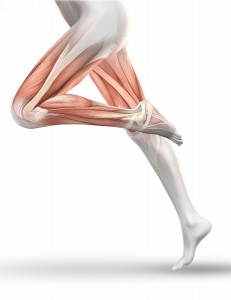Posted on August 20, 2015 by Jenny Cromack
 Biomechanics of Running Part 2
Biomechanics of Running Part 2
The first part of this blog series identified key points during the phases of running in relation to the joint positions and mechanics and highlighted some common faults. This second blog looks at the muscle actions of the major muscles and which phases they contribute to.
Muscle Activity
Quadriceps:
The quadriceps are the large group of muscles that run down the front of the thigh. Their primary job is to straightening (extending) the knee and aid in flexing the hip. During the running cycle their responsibility is to initiate and control this extending of the knee. In the swing phase they start to contract in the latter stage to extend the knee so the foot is swung through ready for initial contact. They remain active through until the mid-stance phase. This activation during the stance phase helps absorb the shock of the ground contact transferring force into the toe off phase.
Hamstrings:
The hamstring muscles are the major muscles in the back of the thigh. These muscles are responsible for bending the knee (flexing) groups of muscles start to contract as they lengthen (eccentrically) in the latter half of the swing phase as the leg straightens ready for initial contact. This contraction helps control the straightening of the leg and absorbs the shock of contact much like the quadriceps.
After initial contact the hamstrings then start to shorten and contract (concentric contraction) to extend the hip and leg backwards into the ground. This propels the body up and forwards and moves the leg into the toe off position.
Calves (Gastrocnemius):
The calves, or the gastrocnemius, are the muscles at the back of the lower leg. They are responsible for pointing the toes and foot and also play a part in flexing the knee. Their contribution to running is similar to the hamstrings as they eccentrically contract in the latter half of the swing phase. This aids the hamstrings in the control of the knee extensions as the leg swings through ready for the next initial contact. It also controls the lifting of the toes (dorsiflexion) so that the foot clears the floor as it swings through.
After the initial contact, in the stance phase, the calf starts to contract concentrically to point the toes (plantarflex), absorb the ground reaction forces, and push the foot backwards into the ground. This helps the hamstrings propel the body upwards and forwards.
Tibialis Anterior:
This muscle is runs up the front of the outer-shin and controls dorsiflexion of the ankle. This muscle contracts concentrically throughout the swing phase lifting the toes and foot up so that the foot clears the floor as the leg swings through preparing for the initial contact and stance phase.
At the point of initial contact the tibialis anterior contracts eccentrically to control the drop of the forefoot and the toes towards the floor. This allows the ground reaction forces to be absorbed as the foot rolls from mid-foot to forefoot and into the toe off.
Energy Production and Transfer
Stretch Reflex
To help maintain efficient energy production during running the stretch reflex is one of the mechanisms by which the body achieves this. This phenomenon consists of the muscle and tendon structures being stretched and storing up potential energy. The recoil of these tendons then releases this potential energy providing energy for the toe off and to propel the body into the next stride.
The best example of this during running is when the foot contacts the ground it stretches the calf and the Achilles tendon storing energy, then as the foot rolls flat the tendon recoils and the calf contracts releasing the stored energy.
Muscular Energy Transfer
This mechanism involves the muscles that cross two joints. As one end of the muscle controls the movement at one joint it transfers that energy into the second joint. The movements at each joints move in opposite directions allowing the energy to be transferred up through the muscle.
An example of this during running would be in the latter stage of the swing and through the stance phase the hamstrings start to flex the knee at one end, but also starts to extend the hip at the other end. Energy is then transferred from the movement of the tibia up to the hip and pelvis. This energy transfer aids the extension of the hip generating power into the toe off so the body is propelled upwards and backwards.
Summary
This article has briefly described the muscle actions that occur in the major muscles during the running cycle. It has also touched upon the transfer of energy as these muscles contract. By understanding which muscles should be firing, and when, along with understanding how energy is produced and transferred we can make conscious efforts to ensure the right muscles are working and our running is more efficient and effective.

